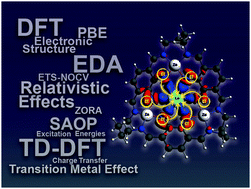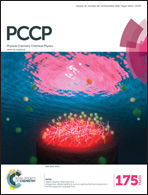Insights into bonding interactions and excitation energies of 3d–4f mixed lanthanide transition metal macrocyclic complexes
Abstract
In this contribution, a computational study of equatorial bound tetranuclear macrocycle (butylene linked) [LnZnII3(HOMBu)]3+ (Ln = La3+, Ce3+) complexes was carried out. Here, the electronic structure, bonding interaction and excitation energies were studied within the relativistic density functional theory framework. From the electronic structure analysis, the frontier molecular orbitals (FMOs) were strongly localized in the d-orbitals of the Zn centers and the f-orbitals of the lanthanide ions. Besides, the inner MOs were found to exhibit a π-character from the organic part of the macrocyclic chain. EDA-NOCV was used as a tool for evaluating the bonding interaction, taking the trinuclear metallomacrocycle (ZnII3HOMBu) and the lanthanide center as fragments. This analysis showed that the interaction between these fragments was slightly covalent; with this covalency being the result of a charge transfer from the metallomacrocyclic ring to the lanthanide. This phenomenon was observed in the deformation density channels obtained from the EDA-NOCV study; in which π- and σ-charge transfer was observed. Finally, the TD-DFT study of the excitation energies evidenced three sets of bands: the first set with the highest intensity represented the ligand to metal charge transfer bands; the second set could be attributed to the 3d–4f electronic transitions between the metal centers; and the third set represented the f–f bands found for the open-shell cerium complex. This class of complexes accomplishes the “antenna effect” principle, which states that highly absorptive transition-metal (TM) complexes can be used to enhance the luminescence of poorly emissive systems, and are introduced in this study as self-sensitizer bimetallic d–f systems with potential applications in near infra-red (NIR) technologies.


 Please wait while we load your content...
Please wait while we load your content...